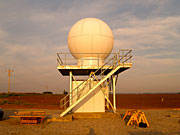- Number 335 |
- April 18, 2011
Improving models of how storm clouds contribute to climate

An X-band scanning ARM
precipitation radar, installed
with Recovery Act funding at
the Southern Great Plains
site in Oklahoma. These
dual-polarization Doppler
radars measure cloud
reflectivity, precipitation,
and velocity at the
9.5-gigahertz frequency.
This week, storm experts from DOE’s Brookhaven Lab will head to Oklahoma! — where the clouds come sweepin’ down the plain, and . . . the wind comes right behind the rain — to take atmospheric measurements aimed at improving global climate models. Working with DOE’s Atmospheric Radiation Measurement (ARM) Climate Research Facility in collaboration with NASA’s Global Precipitation Measurement Mission, the scientists will collect data on many factors that contribute to the formation and lifecycle of convective clouds — those towering masses formed by rising heat that can produce thunderstorms and other severe weather.
The findings from this Midlatitude Continental Convective Cloud Experiment will lead to a better representation of convective storm systems in global climate models, and also improve the fidelity of satellite observations of precipitation.
Using the full range of atmospheric measuring equipment at the ARM Southern Great Plains site in central Oklahoma, including a new, state-of-the-art dual-band scanning radar — installed with funding from the American Recovery and Reinvestment Act — the scientists will perform the most-comprehensive-ever three-dimensional observations of clouds. The ground-based observations will be supplemented by observations from NASA aircraft flying within and above the cloud systems.
The experimental approach is to document, in three dimensions, not only precipitation, but also clouds, winds, and moisture — before, during, and after a storm — in an attempt to provide a holistic view of convective clouds and their feedback with the environment.
“Our goal is to provide the most complete characterization of convective cloud systems and their environment that has ever been obtained, providing information that has never before been available for representing these processes in global climate models,” said Brookhaven meteorologist Michael Jensen, who leads DOE/ARM’s participation in the study.
FULL STORY: http://www.bnl.gov/bnlweb/pubaf/pr/PR_display.asp?prID=1262
[Karen McNulty Walsh, 631.344.8350,
kmcnulty@bnl.gov]
